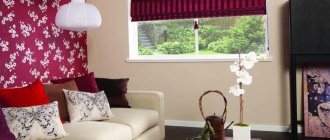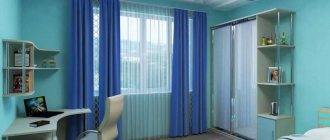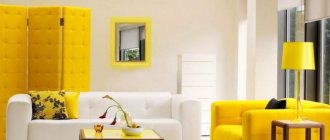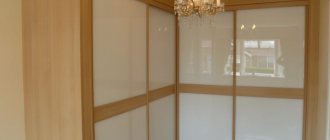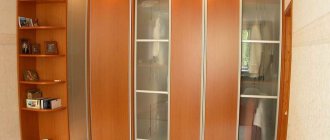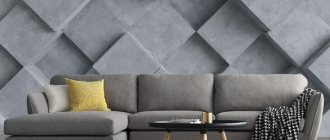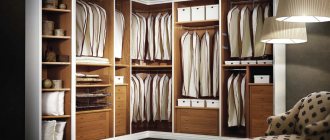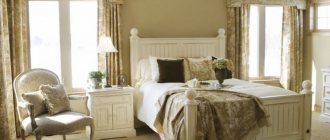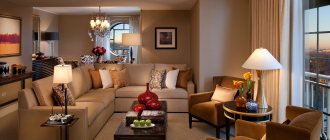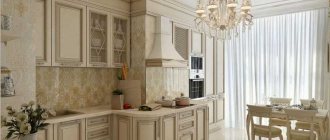Characteristics of paper wallpaper
Wallpaper of this class is divided into two types: simplex and duplex, depending on the number of layers. This type of coating is most often used in wall decoration because it allows them to breathe, but there are also a number of significant disadvantages: they fade quickly, they are easily damaged, and if some kind of contamination appears, it cannot be washed off, you will have to re-glue it.
There are several types of material with different paper densities. If the wallpaper is too thin, then when pasting it may stretch or, on the contrary, shrink, and if it is too thick, it will increase the consumption of glue and require additional surface preparation.
It would be optimal to use paper with an average density of 110-140 g/m2. You can find this information on the product packaging.
Non-woven wallpaper
If you rarely do renovations, then non-woven or vinyl wallpaper will be preferable.
Non-woven fabric is an analogue of paper, but with fabric threads at the base. This type of wallpaper can be used to cover uneven walls; another significant advantage is that it does not shrink during use.
There is an option with a thin layer of vinyl on the surface, then the wall can be easily subjected to wet cleaning or painting, but manufacturers no longer risk talking about the naturalness and environmental friendliness of the chosen type.
Dimensions and glue
Wallpaper comes in standard width (narrow) and wide. At the moment, wide canvases are popular. Gluing work with them goes faster than with standard rolls.
Wallpaper is also distinguished by the presence of large and small patterns, color palette, with or without adjustment, washable or moisture-resistant. By theme: for the living room, bedroom, kitchen, nursery and hallway.
- When purchasing glue, take into account the type of wallpaper, its severity (weight), and the number of rolls (always take a roll in reserve, just in case).
- Paper wallpapers can theoretically be “planted” with any glue, but vinyl and non-woven (or other) wallpapers cannot be glued to an adhesive solution intended for gluing paper samples.
This kind of glue is absolutely not suitable: the canvas will fall off the wall.
Vinyl wallpapers
In versions of vinyl wallpaper, non-woven fabric is used as the bottom layer, but more often paper; the wallpaper is easy to care for, easy to work with, and can be easily washed, cleaned, or painted.
But the downside is that they do not allow oxygen to pass through; because of this property, non-woven wallpaper is rarely recommended for the design of bedrooms, and especially children’s rooms.
By purpose
Here the wallpapers are divided into two large groups:
- For the ceiling, these are wide rolls of non-woven, vinyl or fiberglass wallpaper, liquid wallpaper, photo printing.
- All of the previously listed options are suitable for walls.
The fashion for covering the ceiling with wallpaper has gradually gone away, but for walls it will always be in trend.
Acrylic coating
If you liked the look of the vinyl covering and would like to use similar wallpaper for covering rooms, but are not going to deprive yourself of air, the solution would be to buy acrylic wallpaper.
Outwardly, they resemble vinyl, but the top layer in them is made of foamed acrylic, applied in a dotted manner, so the breathability of the coating does not suffer. Such wallpapers are less wear-resistant, but if you like change and often refresh your interior, this is your option.
Coatings made from natural materials
If you prefer a more expensive but eco-friendly interior, pay attention to natural wallpaper. Their top layer is made of bamboo, straw, veneer, reed, the base is usually paper, but sometimes non-woven fabric is also used. This type of coating gives a special coziness and pristine appearance to your home.
To prevent possible exposure to dust and dirt, such wallpaper is treated with special impregnations. There are also negative aspects when choosing a natural coating:
- Firstly, they are difficult to glue; in most cases, you cannot do this without specialists.
- Secondly, the natural composition is afraid of dampness.
- Thirdly, such finishing accessories do not take color well, and if you choose a bright color, be prepared that after one or two seasons the wallpaper will fade or completely change color.
The high price of such materials, as a rule, does not justify itself; when choosing this option, designers advise taking two types of wallpaper: natural for one wall or part of it, and “simpler” wallpaper for the rest of the space.
Classification by texture
There is also a classification based on surface type:
- Smooth.
- Embossed.
- Silkscreen printing.
- Metal.
- Flock or velor.
- With beads or bugles.
Thanks to additional decorative elements, you can make amazing combinations.
What is fiberglass?
A new type of finishing with the least number of disadvantages is glass wallpaper. A new word in the variety of types of wallpaper for walls. When used, they do not shrink, so they are often used in the design of rooms in new, recently built houses. Such wallpapers are made from glass fibers, they do not contain harmful substances and show great strength when tested in tensile tests.
After gluing them, manufacturers recommend additionally painting the walls with water-based paints. Wallpaper differs from others in that it does not undergo combustion, does not emit smoke and is absolutely not afraid of exposure to water. They have a large margin of safety, their service life is about 30 years, and they can be repainted more than 15 times if necessary.
- Health, vitamins and minerals - discover the key to better health
- Crafts ideas for girls - a review of easy crafts
- How to choose and where to buy a suitcase on wheels?
The coating protects the walls from cracks. Hypoallergenicity is their big advantage, because they do not contain a breeding ground for various types of microorganisms, and you do not have to worry about the appearance of mold or mildew in your home.
So far they have only one drawback - a small selection of patterns, which significantly limits the possibilities of creating a unique room design using such material.
Loft
The loft style in the interior is a fashionable decoration of the living space. Initially, this style was associated with the industrial gloss of attics, abandoned warehouses and factory floors, but today loft designs are one of the trending areas of modern design. Wallpaper in the loft expresses an attractive feeling of freedom and independence.
Loft style wallpapers are different:
- Realistic imitation of natural materials: concrete wallpaper, stone wallpaper, brick wall wallpaper, wallpaper in the form of plaster, imitation wood panels, metal.
- The predominance of natural shades: brick, metal, chestnut, chocolate. This creates a special designer charm and emphasizes the independence of taste.
- Clear relief textures and shiny metallic elements will add a touch of glamor to the loft.
Wallpaper in the Loft style
Wallpaper with fabric trim
When choosing an expensive design, you will certainly be offered textile wallpaper. They look exclusive due to the fact that the top layer is made of expensive fabrics: silk, linen, cotton, and velor. Photographs using this type of wallpaper are extremely often used by designers when advertising their services. Absolutely environmentally friendly material.
Some types of it, for example, from flax, have antiseptic properties. The fabric partially helps insulating the noise and heat of the room.
The width of the roll of such materials allows you to create a coating without seams on the wall. The downside is low resistance to dirt and odors; when gluing, you will need the help of specialists; the price tag for such material is also considerable.
Photo wallpaper
This type of wallpaper is most often used for zoning part of a space and consists of carefully glued parts of an enlarged photograph of good quality.
The market also offers corresponding panels printed on a single wide-format sheet.
Liquid wallpaper - a simple replacement for the classics
For those who consider wallpapering walls a relic of the past, the industry offers liquid wallpaper. Environmentally friendly cellulose is used as the basis for such coatings, and additional design components can include glitter, fibers, and dyes.
The work process is as follows: you buy a bag of dry powder and dilute it with plain water in the proportion required according to the instructions included with the purchase. The material is applied with a spatula; this does not require special skills, but it is better to watch a special video on this topic.
Consumption with proper application is 1 kg per 5 m2 of surface area, which, you see, is not so little. This is a relatively cheap option for wall decoration; its price also depends on the type of decorative elements present in the solution.
This material has a service life of approximately 6 years; when applied, there is no need to worry about joints, and no additional leveling of the walls is required.
- Wallpaper glue - choosing the best composition for different types of wallpaper (60 photos)
- Brown wallpaper in a timely interior: 80 photos of wall designs for different rooms
- Red wallpaper - 55 photos of residential interior design using red
After applying the wallpaper, it is not recommended to carry out any work indoors for 48 hours. Since cellulose is very hygroscopic, the new product cannot be used in damp areas.
The use of photo wallpaper in the interior
Photo wallpapers have not gone out of fashion for many years. They are loved for the ability to choose any pattern in the volume; the standard version of gluing involves two types of wallpaper, when you apply photo wallpaper to one wall, and any plain material to the rest. The reverse side of the photo wallpaper is self-adhesive, which simplifies the finishing process.
The interior design industry has developed a huge catalog of different types of wallpaper to suit every taste and budget. Now the process of transforming the interior is not so physically difficult, it has taken on creative forms and does not take as much time and effort.
Trend
Naturalness and simplicity are gaining increasing popularity in decorating walls with wallpaper. The less pretentiousness and acidity, the better. Preference is given to beige, almond (as an accent) and pastel colors.
To dilute the light tone, cover one wall with photo wallpaper with a 3D effect depicting abstraction (neoclassicism, hi-tech, loft) or landscape, plants, architectural elements (classic, Provence).
Also in fashion are wallpapers with large and floral prints, as well as canvases that imitate various finishing materials.
When choosing wallpaper for your home, the main thing to remember is that it will appeal to those who will look at it every day.
Photos of different types of wallpaper
Did you like the article? Share

0
